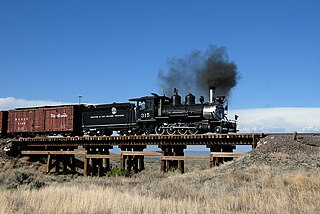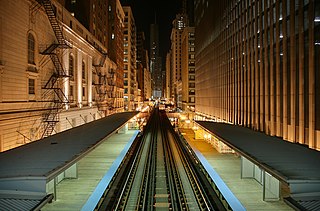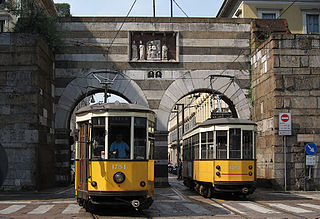
A tram is a type of urban rail transit consisting of a rail vehicle, either alone or coupled as a self-propelled train through a multiple unit, that runs on tramway tracks on urban public streets; some include segments on segregated right-of-way. The tramlines or networks operated as public transport are called tramways or simply trams/streetcars. Many recently built tramways use the contemporary term light rail.

Light rail transit (LRT) is a form of passenger urban rail transit characterized by a combination of tram and rapid transit features. While its rolling stock is similar to that of a traditional tram, it operates at a higher capacity and speed and often on an exclusive right-of-way. In many cities, light rail transit systems more closely resemble, and are therefore indistinguishable from, traditional underground or at-grade subways and heavy-rail metros.

Manchester Metrolink is a tram/light rail system in Greater Manchester, England. The network has 99 stops along 64 miles (103 km) of standard-gauge route, making it the most extensive light rail system in the United Kingdom. Metrolink is owned by the public body Transport for Greater Manchester (TfGM) and operated and maintained under contract by a Keolis/Amey consortium. Over the 2022/23 financial year 36 million passenger journeys were made on the system.

The RATP Group, is a state-owned company (EPIC) that operates public transport systems. Headquartered in Paris, France, the company was formed in 1949 as the Régie Autonome des Transports Parisiens to operate the city's public transport system. While RATP's Paris-related activities are still a major part of its business, its operations have extended since 2002 with the company competing for contracts to operate systems around the world. RATP Dev, the Group's international operations and maintenance subsidiary, is present in 16 countries in Africa, Asia, Australia, Europe and North America.

Conservation and restoration of rail vehicles aims to preserve historic rail vehicles.

A tram-train is a type of light rail vehicle that both meets the standards of a light rail system, and also national mainline standards. Tramcars are adapted to be capable of running on streets like an urban tramway but also be permitted operation alongside mainline trains. This allows services that can utilise both existing urban light rail systems and mainline railway networks and stations. It combines the urban accessibility of a tram or light rail with a mainline train's greater speed in the suburbs.

The F Market & Wharves line is one of several light rail lines in San Francisco, California. Unlike most other lines in the system, the F line runs as a heritage streetcar service, almost exclusively using historic equipment both from San Francisco's retired fleet as well as from cities around the world. While the F line is operated by the San Francisco Municipal Railway (Muni), its operation is supported by Market Street Railway, a nonprofit organization of streetcar enthusiasts which raises funds and helps to restore vintage streetcars.

Urban rail transit is a wide term for various types of local rail systems providing passenger service within and around urban or suburban areas. The set of urban rail systems can be roughly subdivided into the following categories, which sometimes overlap because some systems or lines have aspects of multiple types.
Various terms are used for passenger railway lines and equipment; the usage of these terms differs substantially between areas:
Keolis is a French transportation company that operates public transport systems all over the world. It manages bus, rapid transit, tram, coach networks, rental bikes, car parks, water taxi, cable car, trolleybus, and funicular services. Based in Paris, France, the company is 70% owned by SNCF and 30% owned by the Caisse de dépôt et placement du Québec.

Light rail is a commonly used mode of public transit in North America. The term light rail was coined in 1972 by the Urban Mass Transportation Administration to describe new streetcar transformations which were taking place in Europe and the United States. The Germans used the term Stadtbahn, which is the predecessor to North American light rail, to describe the concept, and many in UMTA wanted to adopt the direct translation, which is city rail. However, in its reports, UMTA finally adopted the term light rail instead.

Streetcars or trolley(car)s were once the chief mode of public transit in hundreds of North American cities and towns. Most of the original urban streetcar systems were either dismantled in the mid-20th century or converted to other modes of operation, such as light rail. Today, only Toronto still operates a streetcar network essentially unchanged in layout and mode of operation.

Although tram systems date to the late 19th and early 20th centuries, many old systems were closed during the mid-20th century because of the advent of automobile travel. This was especially the case in North America, but postwar reductions and shutdowns also occurred on British, French and other Western European urban rail networks. However, traditional tramway systems survived, and eventually even began to thrive from the late 20th century onward, some eventually operating as much as when they were first built over a century ago. Their numbers have been augmented by modern tramway or light rail systems in cities which had discarded this form of transport.

The Milan tramway network is part of the public transport network of Milan, Italy, operated by Azienda Trasporti Milanesi (ATM).
Transdev, formerly Veolia Transdev, is a France-based international private-sector company which operates public transport. It has operations in 17 countries and territories as of November 2020.











